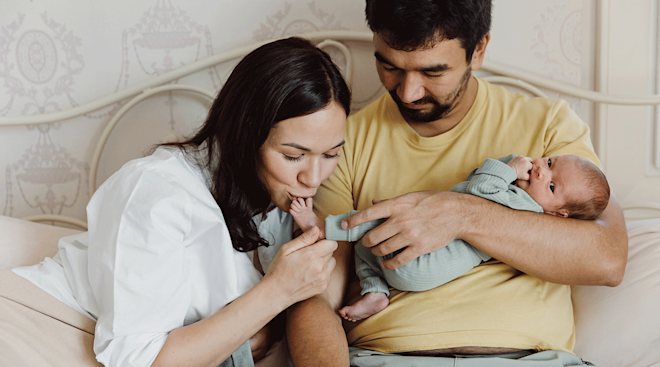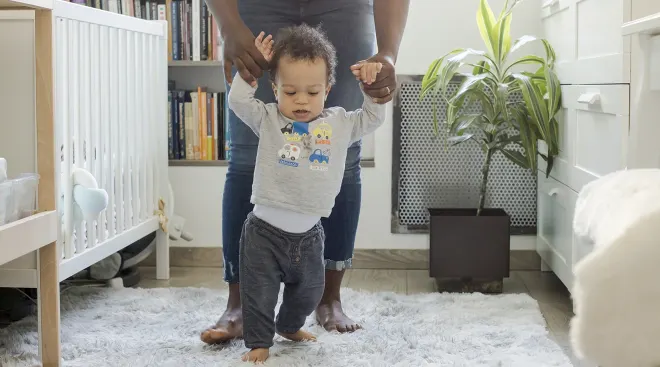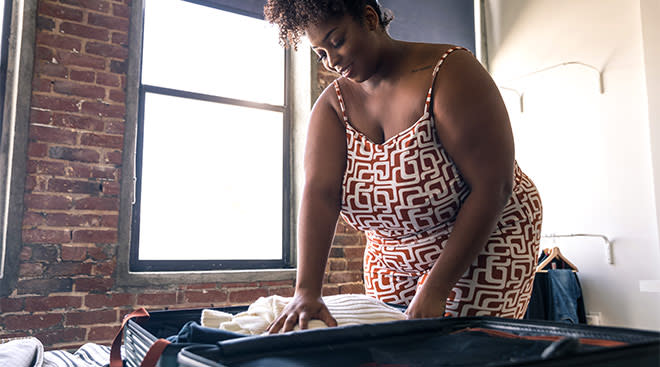Here’s When Babies Roll Over—and How to Keep Them Safe
Have you been diligently practicing tummy time, all the while wondering—when do babies roll over? We don’t blame you. One of baby’s first milestones is rolling over, and it’s such a fun—not to mention important—development, since it’s the first sign baby is becoming more mobile and independent. Once baby can roll from belly to back and back to belly, sitting up and crawling are usually not far behind. But in the meantime, you may be wondering: At what age do babies purposefully roll over? Moreover, what should you do if baby rolls over in their sleep? Read on to learn the answers to your burning questions, straight from pediatricians.
Watching baby grow and gain strength is pretty thrilling, and it’s natural to wonder how soon they’ll be showing off their next big skill. So when do babies roll over?
At what age do babies roll over?
The exact age babies roll over varies from child to child. Babies can start rolling over as young as 3 to 4 months old, says Deena Blanchard, MD, a pediatrician in New York City. It takes them a few months after birth to build up the necessary strength—including neck and arm muscles and good head control—to pull off this physical feat. The American Academy of Pediatrics (AAP) says that by 7 months old, most babies have mastered the art of rolling over.
It’s possible for babies to roll over even earlier than the three- to four-month mark—but that tends to be more of an accidental flop and not an intentional movement. “Sometimes I get a 5-week-old who’s managed to flip herself over because they were frustrated doing tummy time, moving around a lot and not enjoying being on their stomach, so they accidentally rolled over,” Blanchard says. “It doesn’t mean they’ll continue to do so.”
When do babies roll over from tummy to back?
Most babies will first start trying to roll from their stomachs onto their backs because it’s generally easier. “Babies are definitely helped by momentum and gravity,” Blanchard says.
When do babies roll over from back to tummy?
So when do babies roll over from back to tummy? They tend to get this rolling motion down a month or so after they begin rolling from belly to back. If you notice baby trying to roll from back to tummy, though, don’t stop baby rolling over—it’s actually a good sign. According to Blanchard, “going from back to front definitely requires more strength, so if baby can do that, chances are they’re also capable of rolling from tummy to back.”
Can baby roll over too early?
Many babies will start to intentionally roll over when they’re around 3 or 4 months old, but some may accidentally flip over on occasion before then. However, “if they’re consistently rolling over at a very young age—before 3 months—and their muscles look very stiff, then it warrants a call to your pediatrician” to rule out a potential nervous system disorder or birth trauma, says Dina DiMaggio Walters, MD, a pediatrician at NYU Langone in New York City.
Rolling over at a very young age could also potentially indicate abnormal reflexes. Newborns typically have what’s called the tonic neck or fencing reflex, which may prevent them from rolling over in those first few weeks. When a newborn’s face is turned to one side, baby’s arm and leg on that side extend while the opposite arm and leg flex. “It’s nature’s built-in mechanism for preventing SIDS,” says Cheryl Wu, MD, a retired pediatrician in New York City. As the reflex starts to disappear (it should be completely gone by 6 months old) and you notice baby has the strength and muscle tone to hold their head up more, you can take those as signs that you’ll soon see baby rolling over.
When it comes to big milestones, you’re probably keeping an eye out for signals that baby is ready to conquer new skills. (After all, you might want to have your camera ready for the special moment!) So what are some signs baby is close to rolling over?
You’ll likely start to notice progress around the four-month mark—that’s when baby’s growing body starts to proportionally catch up to their head (which is comparatively large at birth) and baby’s overall muscle strength improves. It’s this combination that’ll help baby take that adorable mini push-up and roll with it into a bigger movement. “You’ll see baby slowly start lifting their head higher, then they’ll be able to push with their arms and finally they’ll get their chest off the floor,” Blanchard says.
According to DiMaggio Walters, some other signs baby is ready to roll over include:
- Rocking on their back or belly
- Kicking their legs back and forth and trying to cross one leg over their body
- Arching their back
- Pushing up on their hands and lifting their chest off the ground
Wondering how to teach baby to roll over? For starters, make sure your little one is getting plenty of tummy time. “For a newborn, tummy time is super-important muscle training,” Blanchard says, adding that their level of strength is key to determining when babies roll over.
Other than that, the best way for you to encourage baby to roll over is to physically guide them along, teaching them what it feels like to move. “I put babies on their left side and extend the left arm so they don’t get stuck,” Wu says. “Then I pull gently on the right arm to teach them what it feels like to move.”
Keep in mind that the sensation of rolling over is completely new and can be a little shocking or scary for baby. “They have this ‘What just happened?’ look on their faces,” Wu says. Don’t be surprised if baby cries at first. But after they experience it a few times—and hear you clapping and cheering—baby will likely be more eager to try it out.
Here’s how to help baby roll over all on their own:
- Turn tummy time into playtime. During tummy time, place toys out of baby’s reach to encourage your little one to roll toward them. You can also try getting down on one side of baby and talking to them. Be sure to give lots of positive reinforcement too. “At 4 months old, babies are social beings and love seeing their parents smile. If they see that rolling got a good result, they might be encouraged to keep trying,” Blanchard says, adding that if you have an older child, they can also get on the floor to cheer baby on. “This is a win-win, because baby is probably obsessed with their older sibling, and the big brother or big sister gets praised for interacting in a nice way. Tummy time can be a tool for bringing the family together.”
- Let baby go naked. Experiment with baby rolling over in a more, um, natural way. Try letting your little one spend some time naked on the floor each day, since diapers can restrict movement in the hips and legs. “This way babies are free to experiment and move around,” says Dan Rindler, MM, GCFP, a certified Feldenkrais exercise-therapy practitioner and music teacher in New York City. “I’ve had many parents tell me baby did something new during the time the child was naked.”
- Stop swaddling. Swaddling baby for the first few months of life can be a great sleep aid, but by 3 to 4 months of age, they’ll likely be ready to sleep without a swaddle, Blanchard says. This not only helps lower the risk of suffocation, but also lets baby practice rolling over in their sleep. “Babies experiment a lot with movement in their sleep, and being swaddled can limit that,” Rindler says.
- Limit “container time.” Wondering how to help baby learn to roll over as you go about your busy daily routine? During the day, help baby roll over by limiting the time they spend in anything that hinders movement, such as bouncers, swings, car seats (unless you’re driving!) and activity centers. “These days there are a million gadgets for babies to be in, and they could easily spend a whole day going from one to the other,” Blanchard says. “But you want kids to be in the position that’s natural for them to develop the muscles they need to move forward.” Keep it simple, sticking to a play gym and/or activity mat.
Since babies can sometimes roll over unexpectedly, Blanchard cautions that the only safe places to leave baby unattended are a crib, playard or bassinet (provided they can’t sit up yet, of course). “Early on, baby is untrustworthy—you don’t want to be on the phone with your doctor at 2 a.m. because baby rolled off the bed or the changing table,” Blanchard says.
Once baby is intentionally rolling, it’s important to keep their space clear of anything that could get in their way and potentially obstruct their breathing or pose a choking hazard. “Some babies roll crazy fast and can rake objects with their hands—so a 6-month-old getting hold of something tiny, like a raisin, and bringing it to their face is definitely a possibility,” Blanchard says. Don’t wait until baby is crawling to babyproof your house.
Baby rolling over in sleep? It can be nerve-wracking to discover baby has rolled over. Of course, for safe sleep it’s important to place baby on their back. But if baby is already comfortable rolling both ways, there’s no need to reposition them in the middle of the night, notes the AAP.
“If baby is consistently rolling over during the day and rolls over in their sleep, you don’t need to reposition them,” agrees Whitney Casares, MD, a board-certified pediatrician and author of the forthcoming book Doing It All. But it’s also important to keep baby’s sleep space safe, she adds. “Make sure the surface they are sleeping on is safe by using a firm crib mattress, by not swaddling your older infant, by assuring they can lift their heads well enough to breathe easily when on their belly and by eliminating any extra objects in the crib,” adds Casares.
Regardless of the age babies roll over, whenever they seem like they’re about to start, it’s a signal to stop swaddling them during sleep, says the AAP. If your little one tries to roll over with their arms swaddled in, they may get stuck mid-roll or find themselves face-down and unable to roll back, putting them in an unsafe position. Try transitioning to a sleep sack with arm holes, which will allow baby to safely move around more freely.
So baby has rolled over—now what? “After rolling, many babies start to sit up on their own and crawl,” notes Casares. “These skills can develop at any time but generally occur a month to three months after rolling.” According to the AAP, most babies sit without support by around 8 months, master crawling between 7 to 10 months and pull themselves up to stand by 12 months. Don’t worry if baby’s not reaching every milestone with textbook precision—babies tend to do things on their own time!
Although there’s a wide age range for when babies roll over, Blanchard says at the six-month well visit, she’s looking for babies to be close to rolling either from back to front or stomach to back. If baby’s not rolling over at 6 months, or similarly, if baby has stopped rolling over, consider a trip to the doctor. “Babies might not roll over right at 6 months, but if you aren’t seeing any attempts at movement, definitely discuss it with your pediatrician,” she says. “If your doctor thinks there may be a developmental delay, you’ll be able to work together to figure out what the next steps should be, like physical therapy.”
Please note: The Bump and the materials and information it contains are not intended to, and do not constitute, medical or other health advice or diagnosis and should not be used as such. You should always consult with a qualified physician or health professional about your specific circumstances.
Plus, more from The Bump:
Deena Blanchard, MD, MPH, is a pediatrician in New York City. She earned her medical degree from Albert Einstein College of Medicine in 2006 and completed her residency training at Columbia University. She also earned a master’s of public health from Temple University in 2002.
Whitney Casares, MD, MPH, FAAP, is a board-certified pediatrician, author, American Academy of Pediatrics spokesperson, and the CEO and founder of Modern Mommy Doc. She is the author of three books: The Working Mom Blueprint, The New Baby Blueprint and Doing It All. She earned her medical degree from the University of Vermont and completed her pediatrics residency at Stanford University in California.
Dina DiMaggio Walters, MD, is a pediatrician at Pediatric Associates of NYC and at NYU Langone Medical Center, and serves as a spokesperson for the American Academy of Pediatrics.
Dan Rindler, MM, GCFP, is a guild-certified Feldenkrais exercise-therapy practitioner and music teacher in New York City.
Cheryl Wu, MD, is a formerly practicing pediatrician in New York City. She earned her medical degree from University of Medicine and Dentistry of New Jersey and completed her pediatric residency training at St. Christopher’s Hospital for Children in Philadelphia, PA.
Healthy Children (American Academy of Pediatrics), Movement Milestones: Babies 4 to 7 Months, March 2021
Tonic Neck Reflex, StatPearls, May 2023
Healthy Children (American Academy of Pediatrics), How to Keep Your Sleeping Baby Safe: AAP Policy Explained, October 2023
Healthy Children (American Academy of Pediatrics), Movement: Babies 8 to 12 Months, April 2021
Healthy Children (American Academy of Pediatrics), Developmental Milestones: 12 Months, June 2009
Learn how we ensure the accuracy of our content through our editorial and medical review process.
Navigate forward to interact with the calendar and select a date. Press the question mark key to get the keyboard shortcuts for changing dates.




















































